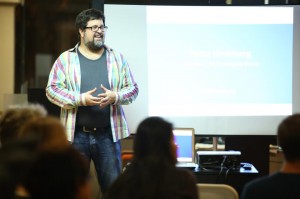One of the many things that came from the UCB BrainJams event was this great idea for setting up a P2P knowledge sharing event within a networking space. We are actually going to do this within the context of the next BrainJams event in New Orleans on Thursday May 4 as well. When combined with an initial session of one-one-one speed networking like we did @ SRI in December, I think this is the powerful one-two punch that will help define what BrainJams are and why they are different from traditional conferences. The other important, unpublished, but thoroughly discussed thought I will write about later, is focused on group to group collaboration (G2G). I continue to try to figure out how to maximize the impact of G2G, though efforts to foster it are proceeding at a snail’s pace.
Fortunately I think we are going to be doing another variation on this idea with One Web Day in the guide of what is currently just called “Web Teach-In”. I realize others have done this before (like Socrates perhaps?) but it really is an incredible way for us all to reconnect with each other as fellow humans and work together towards bettering our society.
—
I would like to extend the “show, do, teach” model through BrainJams. I really envision an event session where someone could show another person how to do something, that person could then do it themselves and then that person would teach someone else and this could go around and around like the one on one networking at previous BrainJams. Sort of a “Show and Teach Jam” where peer to peer learning is the key connector between people. This can be done in long format sessions with groups of people (ie, an internal team learning to use Drupal or Movable Type) or as ‘break through’ sessions that are focused on a given tool or type of tool.
What we will look at below can be done in an hour format with a variety of people, though the full ‘hand off’ between teacher and learner is not completed. Instead, an individual would be in charge of a station with a focused goal and have 3-4 minutes to show how to do something (like setup a Blogger account) and the learners have a few minutes more to do it themselves. Stations can be set up around the space with the Peer Leaders bringing their own laptops from which to demonstrate and teach.
Peer Leaders are requested to sign up to lead a lesson a specific set of topics for each event. We can choose to focus on a certain type of tool or we can cover multiple tools or we can even lead it up to the Peer Leaders to choose for themselves. For the first one, I recommend taking an introductory approach with the end goal being that those who don’t know much about how to work with the new technologies can leave feeling they know what to do.
The format will allow for four 10 minute sessions across an hour, with 5 minutes in between to move on to the next session, or ask important follow-up questions. These will be held in small groups of 1-5 people around a laptop screen (sitting on a podium, bar top, bar table or pedestal). Five people is really the maximum, 2-3 would be ideal. The Peer Leader will speak to the same topic for each of the four sessions so that participants can move around the room to the one’s that are most interesting. Sign up sheets will be placed at each station at the beginning of the event so participants can sign up for the sessions they want.
Each session will focus on a demonstration of how to accomplish a particular task and should include one of the Peer Learners actually doing what the Peer Leader is demonstrating. For instance, if the Peer Leader is showing how to set up a blog on LiveJournal or Blogger, one of the Peer Learners should then set up a blog for themselves.
Possible topical lessons could include:
– How to set up your blog
– How to include tags in your blog
– Social Bookmarking in Action
– Tags as conversation
– Blogrolls / OPML
– Online Calendars
– Using a Feed Reader for RSS
– Other suggestions from potential Peer Leaders
In short, these sessions will be designed to teach participants enough of how to do something to get them past initial fears or trepidations so that they can get out and really try to do it on their own. The end goal is that the Peer Learners will eventually become Peer Leaders who go off and teach other people how to do the things that they learned. Other formats can be modified from these principles to achieve deeper learning, but the core idea is to make it personal, one to one or one to few really makes this work. It may take a little longer, but the human connection makes it invaluable and in the end is exactly what the web is all about – people helping people.
—
This is another of the FreeIdeas I promised to write about back in December (which need to be tagged properly still)> Expect more to be coming over the next couple of weeks in light of nearing the end of a reflective cycle and being able to clearly see some cool solutions to many of the things I have been thinking about. I am really excited to have the chance to work this out with the One Web Day folks and look forward to doing some other similar events with other groups in the near future.
Technorati Tags: ad-hoc collaboration, ad-hoc+collaboration, brainjams, brainjams25feb2006, brainjams:freeideas, brainjams:neworleans, brainjams:planning, knowledgeeconomy, net2, openspace, freeideas=chrisheuer, socialconference, The+Open+Web, unconference, Web2.1
